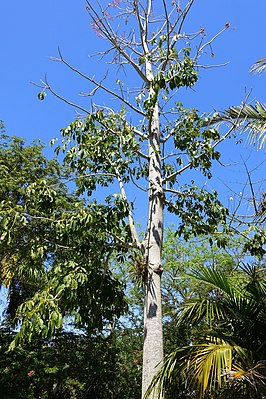Bernoullia flammea
| Bernoullia flammea | ||||||||||||
|---|---|---|---|---|---|---|---|---|---|---|---|---|

Bernoullia flammea |
||||||||||||
| Systematics | ||||||||||||
|
||||||||||||
| Scientific name | ||||||||||||
| Bernoullia flammea | ||||||||||||
| Olive. |
Bernoullia flammea is a tree in the mallow family from the subfamily of the wool tree from Central America to southern Mexico and Colombia .
description
Bernoullia flammea grows as a tree to over 30 meters high. The trunk diameter reaches up to 100 centimeters. The fine-furrowed, relatively smooth bark is gray-brown.
The stalked leaves are hand-shaped with (3) 5–7 leaflets . The petiole is 6–22 inches long. The entire and obovate to elliptical, pointed to pointed, almost glabrous and short-stalked leaflets are about 7-20 centimeters long. The leaflet stalk is 1–2 centimeters long.
There are terminal, long and fine reddish hairy, one-sided, dense grapes ( winding ) formed individually or in panicles are. The short-stalked, orange-red to red and hermaphrodite flowers are double- coated . The cup-shaped, outside bald and inside hairy calyx is more or less five-lobed. The 5 petals with velvety hair on the inside are obovate to oblong with rolled-up tips. The up to 15–20 stamens are fused in a fleshy, thick and long, protruding, divided, fine-haired tube, cut on one side in the upper half, from which the stylus protrudes laterally through the slit. The fünfkammerige, -kantige, bare ovary is above to semi upper constant with a long, slightly conical and plump, bare stylus.
There are woody, five-lobed and up to 20-25 centimeters long, 5-6 centimeters wide, dark brown, hard, bald, ellipsoidal to obscure-narrow-shaped as well as slightly pentagonal, angular, short-pointed, multi-seeded capsule fruits formed, which extend from the tip to open. The many yellow-brownish, flat seeds are winged on one side and are 5–7 centimeters long with wings, without wings they are 1–2 centimeters long.
Taxonomy
The first description was in 1876 by Daniel Oliver in Hooker's Icon. Pl. 12: 62, t. 1169, 1170.
use
The wood is quite light and soft and not very durable, it is known as Cucharo or Mapola . It is used for some applications.
literature
- Fieldiana. Flora of Guatemala, 24, Part VI, 1949, p. 387 f, online at biodiversitylibrary.org.
- Erika Margarita Pagaza Calderón, Rafael Fernández Nava: La familia Bombacaceae en la Cuenca del río Balsas, México. In: Polibotánica. Núm. 17, 2004, pp. 71-102, online at researchgate.net.
- JR Velázquez, PS Colín, GJ García: Frutos y semillas de árboles tropicales de México. Instituto Nacional de Ecología, 2009, p. 24, online at academia.edu.
- K. Kubitzki , C. Bayer: The Families and Genera of Vascular Plants. Vol. V: Flowering Plants Dicotyledons , Springer, 2003, ISBN 978-3-642-07680-0 , pp. 275 f.
Web links
- Flora de Guerrero No. 54, Nelly Diego-Pérez, Rosa María Fonseca: Bombacaceae. Universidad Nacional Autónoma de México, 2013, ISBN 978-607-02-4203-8 (PDF; 21.8 MB), at Biologia, Facultad de Ciencias, UNAM.
- Bernoullia flammea is one of the most unusual flowers of the Maya heartland of Peten. at maya-ethnobotany.org, accessed November 24, 2019.
- Bernoullia flammea on inaturalist.org (pictures).
Individual evidence
- ↑ online at biodiversitylibrary.org.
- ^ Report on a Wood Testing Program Carried out for UNDP / SF Project 234. Panama, 1971, p. 17 f, limited preview in the Google book search.
- ^ Samuel J. Record, Robert W. Hess: Timbers Of The New World. 4th Edition, Yale Univ. Print, 1949, p. 90 f, archive.org .
- ↑ Michael J. Balick, Rosita Arvigo: Messages from the Gods. Oxford Univ. Press, 2015, ISBN 978-0-19-996576-2 , p. 362.